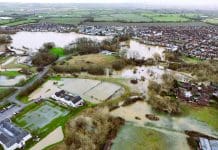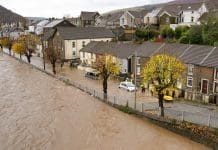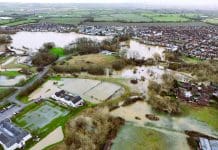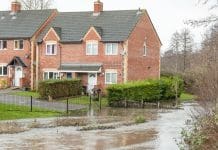Aquobex discuss the terminology and technical jargon of flood resilience to make things clear
Most industries and professions are guilty talking jargon; it makes communication easier among those in the know but jargon can often isolate or shut out those who don’t quite understand it and the field of flood resilience is no different. In an attempt to bridge the gap between two related but often disparate fields, this article will demystify some terms that are used widely within the field of flood resilience and explain how they might relate to architects.
PLP (Property-level protection)
This is quite self-explanatory but could be misconstrued. It is a relatively new phrase that has come about as a result of changes in political shifts and an attempt to improve public spending. Traditionally flood protection was the remit of civil engineers designing dams, sluice gates, culverts and dykes. With the decentralisation of government over the years and with the realisation that these civil projects could never feasibly protect all homes at risk of flood damage, a new approach emerged which is based on the principle of protecting individual buildings, especially where they are not protected by larger measures.
Protection should be considered in layers with river and coastal management being the first layer, large engineering projects being the second, temporary barriers that protect whole communities third and protection of individual properties fourth. This final stage of protection is the point where architects can have the biggest input and can take the form of small scale flood walls away from the building, removable barriers on doors and windows, the installation of pumps, moving expensive contents to higher levels and the installation of water resistant insulation to name just a few.
There are two other key approaches to note which constitute property-level protection; resistance and resilience.
Resistance
Resistance is quite simply put as resisting the entry of water into a building. This is usually the most logical and effective method of preventing damage to a building or its contents. If water has made its way to the fabric of a building, stopping it from getting into the structure and into the interior is a sure way of minimising damage.
For the architect this can be in the form of specifying a number of measures ranging from a water impermeable render externally, installing flood doors, repointing brickwork with a water impermeable mortar or specifying temporary flood barriers.
However, some hidden dangers lie in this approach. As water builds up on the external face of the structure, the forces acting on the wall can become extremely high eventually resulting in structural damage to the building, a worst case scenario. To avoid this, it is recommended to allow water to enter the property once the flood water reaches a certain height. This height will depend on the structural make-up of the building and a structural engineer should be consulted. A general rule is that a cavity wall will stand no more than 600mm at which stage water must be allowed to enter the property.
This may seem counterproductive, but this is where resilience comes in.
Resilience
Resilient flood protection is the second prong in the property-level protection approach. It is based on the understanding that it may be impossible to keep all water out of a property. Barriers may not be installed because the homeowner is on holidays or barriers and resistance measures may be overtopped.
To avoid damage that may result from the entry of water into the property it is essential to minimise the damage that would result. This can mean the specification of materials that display minimal water damage or it can be design related changes to normal practice such as the installation of electrics above the predicted flood height.
Damage to materials varies greatly and is often misunderstood by homeowners and professionals alike. Mould growth, material damage, dimensional changes to materials, debonding, delamination and reduction insulating properties are just some of the potential damage that can result from water entry but empirical evidence based on research is lacking within the industry. At Oxford Brookes University and Aquobex we are carrying out that research and establishing the evidence base needed to establish standards for effective protection and remediation.
Many measures can be very cost effective and can be implemented either at design stage of a new construction or when protective measures are being installed in an existing property. Unfortunately, these measures are usually only considered after a property has already been flooded.
A big barrier to the implementation of these measures is that the insurance industry is yet to recognise the reduction in damage risk that they can offer, mostly because they are still not able to evidence and quantify the reductions in risk that they offer. Again, an area that our research is addressing.
1 in 100 year flood
Possibly the biggest misnomer in the industry, the use of the term ‘year’ leads many to think that if they experience a 1 in 100 year flood the won’t see another one for 100 years. In reality, this means that the risk of a flood of this level is 1 in 100 for any given year, meaning that the risk of this level happening this year is the same as it happening next year. This is one piece of terminology that desperately needs to be changed.
Recovery and recovery time
Recovery is simply the process of getting a building back to a habitable condition again after flooding. This can entail the removal of damaged fixings and finishes to speed up drying times, forced drying using heaters and dessicant machines, and the repair of recoverable elements of the building and contents.
Architects can play a critical role in this stage by specifying the most appropriate materials that dry out quickly or are easily removed and replaced at a low cost. The role for the architect is making the decision on which materials can offer the best balance between cost, speed of drying, speed of replacement and life cycle. Of course all of these issues need to be balanced with the wider issues of architectural design such as insulating properties, sustainability and aesthetic qualities.
Future research at Oxford Brookes and Aquobex will produce a methodology for architects to be able to make complex decisions with the best confidence and at the most appropriate stages of a project.
Round-up
When working on projects that may be at risk of flooding, architects will have to deal with flood surveyors, planners and flood protection installers and experts. It is essential that communication barriers are broken down and there is no confusion by the use of terms. We hope this article will help architects to interpret the world of flood risk management.
For more information, click here.













